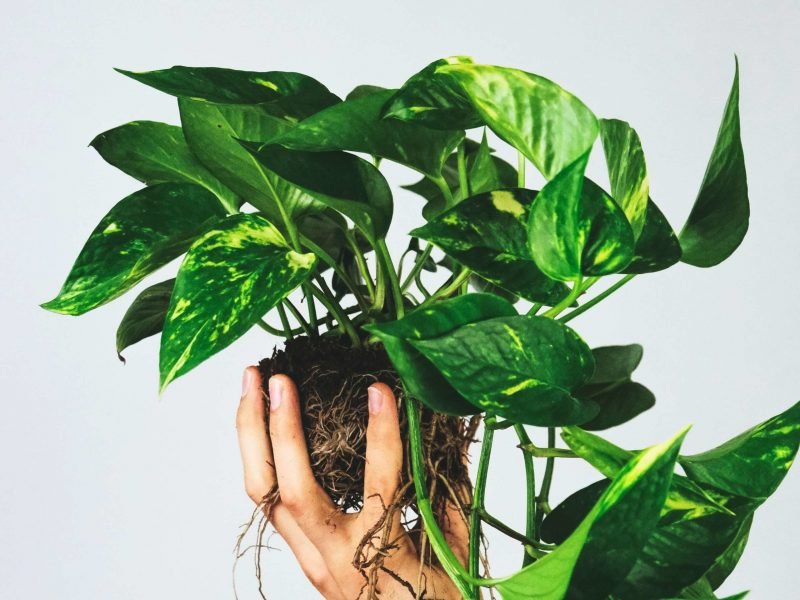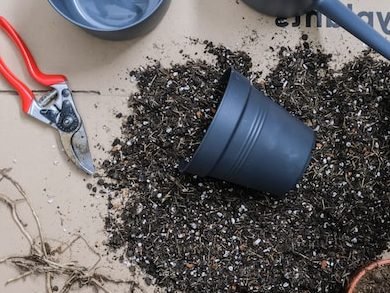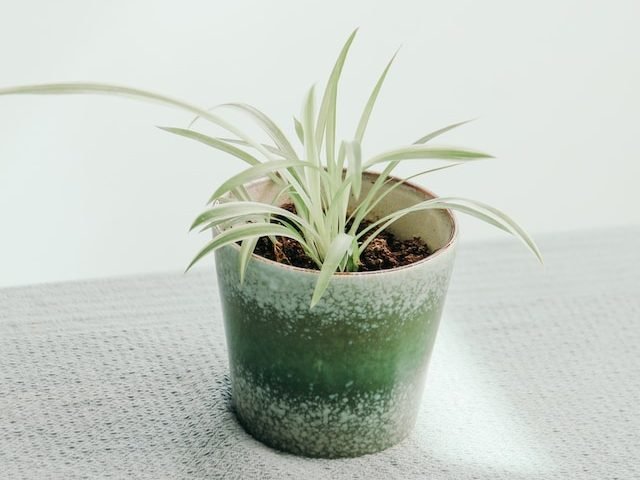
These incredible cascading plants can deal with a range of environments but this doesn’t mean that they won’t develop brown leaves if something isn’t right. There are a few different reasons why your Devil’s Ivy might have brown leaves, from humidity issues to watering problems. It’s important that you take a good look over your Devil’s Ivy whilst going through the different reasons so you can see what is causing the brown leaves on your plant. Act quickly to prevent the problem from taking over your plant entirely as if not solved, some of these issues can kill your plant.
Low humidity in the air can cause brown edges and leaf tips
Devil’s Ivy plants like a little boost to the humidity level and can really struggle in homes with particularly dry air. This tends to be especially damaging in the cold dark months of autumn and winter as central heating will really dry out the air in your home.
A lack of humidity will tend to make the leaves on your Devil’s Ivy plant turn light brown, dry and crispy, from the tips and edges inwards. Luckily, there are a few methods you can do to give the humidity a little bit of a boost and prevent more brown leaf tips on your Devil’s Ivy.
Regularly mist the leaves
One of the simplest ways to increase the humidity for your houseplants and reduce the risk of brown leaves is to mist them with a spray bottle a couple of times a week. This will not only lift the humidity level, but it can also get rid of any dust that’s lingering on the leaves, which helps maximise the sunlight and keeps your plant looking clean.
Build a pebble tray
Place your houseplants over a tray of small pebbles with fresh water over the top. Over the day water from the tray will evaporate giving the plants above exactly what they’re looking for. This can help avoid brown leaves in future. Ensure that the water level never reaches over halfway up the pebbles as otherwise, you risk the roots of your Devil’s Ivy sitting in water which will cause root rot and more brown leaves.
Give your Devil’s Ivy a shower
If you’re looking for a short term but instant boost to the humidity level, then showering your Devil’s Ivy is a good way to prevent more brown leaf tips. Just place your Devil’s Ivy in the shower and wash the leaves down with lukewarm water (keeping the water pressure fairly low so you don’t damage the leaves or the vines).
Move your Devil’s Ivy to the bathroom or kitchen
If you’re lucky enough to have great lighting in either your bathroom or kitchen you can move your Devil’s Ivy in there to increase the humidity level. The running water from your showers and the steam from cooking means that these two rooms tend to be the most humid in your home.
Invest in a humidifier
They’re relatively affordable little devices and they make keeping a consistent humidity level so much easier. Your tropical and humidity loving plants will really thrive if you invest in one and this will really reduce the risk of more brown leaves developing on your Devil’s Ivy.
Sunburn from direct light can also cause brown leaves
Your Devil’s Ivy may also be turning brown due to it getting too much direct sunlight. Devil’s Ivys don’t like direct sunshine and south-facing windows can sometimes give your Devil’s Ivy too much direct light which will be causing brown leaves. During winter you can get away with giving your plant more light as the sun is less intense but it’s best to move your plants a little further away from the window in warmer months to avoid any brown leaf burn.
You can tell if your Devil’s Ivy is receiving too much sunlight if it is showing sights of sunspots. These are brown spots that start to show up across the leaves that are getting the most sunlight. Unfortunately, once the leaves on your Devil’s Ivy have been burnt by the intense light, there is no returning to luscious green or variegated growth. Trim away any leaves that are particularly affected to help your plant focus its energy on growing new leaves.
Cold temperatures can also result in brown leaves
Hotspots or cold drafts can also cause your Devil’s Ivy to develop brown leaves, in particular brown spots on the leaves. Hotspots and brown leaves can happen when your Devil’s Ivy plant is too close to the window in summer and is receiving too much direct light or if your plant is within 1 metre of a radiator or heating vent. Make sure you are ventilating the room well and it can be a good idea to buy a digital thermometer to check on the temperature levels near your plant.
Cold drafts can also really affect your Devil’s Ivy and cause brown leaves. A consistent draft of cold air coming in from outside through cracks in doors/windows can be harmful to your Devil’s Ivy. They can deal with the old spot of cold weather but over time this will impact your plant’s health. Make sure you draft proof any doors or windows that your Devil’s Ivy (or any other plants with brown leaves) are close to.
Brown leaves can indicate overwatering
As a plant parent, it can be super easy to want to give your Devil’s Ivy all the care in the world. But too much love (in the form of water) can actually be very harmful to your plant and can often cause brown leaves and other problems.
Consistent overwatering will mean it will start to develop root rot and your Devil’s Ivy will start to develop brown leaves from the base of the plant down the vines. This will cause your Devil’s Ivy to turn brown, droop down and the vines may start to turn soft.
Devil’s Ivy plants need to be watered no more than twice a week in the hottest months of the year, and less frequently in autumn and winter to prevent waterlogged soil and brown leaves.
If you think that overwatering is the cause of the brown leaves on your Devil’s Ivy, it’s best to replace the soil straight away rather than just sit and wait for it to dry up over time. Be careful when removing the potting mix from the roots as you don’t want to cause any further damage. Delicately shaking the roots and running your fingers through them is the best way to remove the potting mix.
Make sure to check the moisture in the soil before you water your Devil’s Ivy. There are two really easy ways to make sure that it definitely needs water. First check the moisture at the top of the pot, if it’s still a little moist then wait a few days before watering again. You can also lift up your Devil’s Ivy to check the weight of the plant before and after watering. You will then start to be able to gauge how heavy the soil is when it is in need of water. (Don’t try this with really large plants as you don’t want to risk hurting yourself).
Underwatering can also lead to brown leaves
Don’t worry if you forget the occasional watering, but consistent underwatering can also cause some real issues, with light brown, crispy leaves being the main one.
Before you start pouring water over your Devil’s Ivy to make up for the lack of it, it’s important that you are sure that it’s the right cause. Remove your plant from the pot and see how dry the potting mix feels. If it’s bone dry and the roots look crispy, then underwatering is the most likely culprit of the brown leaves on your Devil’s Ivy. The best way to fix your underwatered Devil’s Ivy is to water your plant a little bit once a day for about a week. This will help to gradually reintroduce water without shocking your plant by changing the environment too rapidly.
We recommend picking up a moisture meter to help you keep an eye on when your Devil’s Ivy needs more (or less) water which will help to avoid brown leaves in future.
Should I trim away the brown leaves on my Devil’s Ivy Plant?
If only the edges of the leaves have turned brown on your Devil’s Ivy, then it can be a good idea to leave these as they aren’t all dead and can still be valuable to your plant. However, any leaves that are fully brown and have crisped and dried up should be removed from your plant.
This will stop your plant from wasting energy trying to revive them. Instead, it allows your Devil’s Ivy Plant to focus all of its energy on new healthy growth.
Do brown leaves mean my Devil’s Ivy Plant is dying?
Brown leaves don’t always mean that your Devil’s Ivy will die but it is most commonly a sign of unhappiness. It means that something either in the care it’s receiving or its environment isn’t quite right.
If the issue isn’t dealt with it may escalate and cause real damage to your plant (and maybe even cause it to die) so we recommend acting quickly when you spot brown leaves on your Devil’s Ivy.
Can the brown leaves on my Devil’s Ivy turn green again?
Unfortunately no they won’t turn green again.
Once the leaves on your Devil’s Ivy Plant have turned brown, there is no reversing this as that part of the leaf has died.
Those are the most common reasons why Devil’s Ivy plants develop brown leaves. When changing anything about your plant’s care or environment, make sure to check in on your plant daily to see if the changes are having a positive or negative impact.
To learn more about how to care for your plant, as well as the different propagation methods you can use and how to spot other common problems, check out our Devil’s Ivy care guide.















